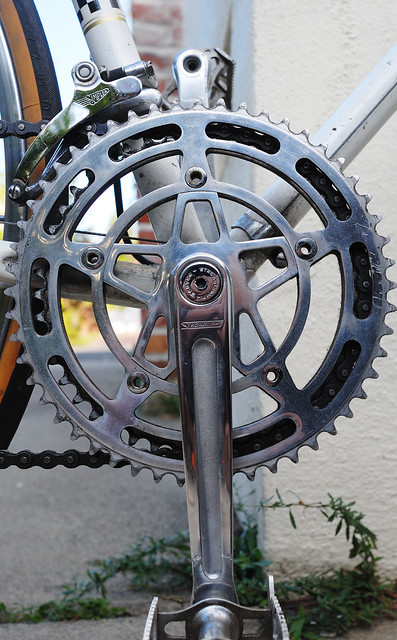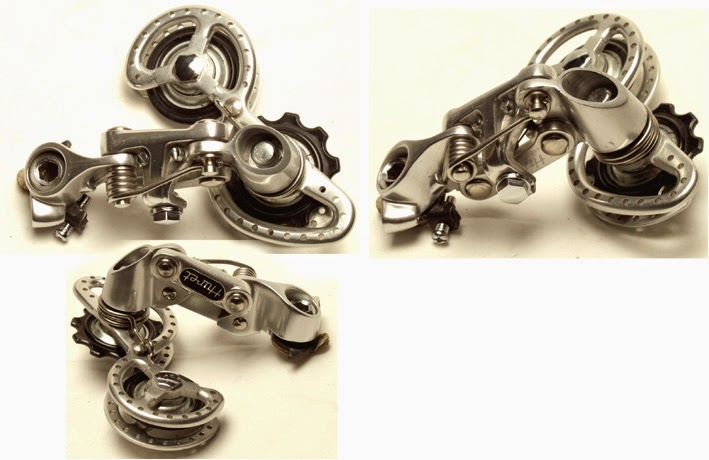To many bicycle enthusiasts, “classic” components
come in a spectrum of colors ranging from silver mist to gleaming chrome. Some purists—or pedants who fancy themselves
as such—believe that all components worth using are polished, preferably to a
mirror finish. Cranksets like the
Stronglight 93, 63 and 49, Specialites TA Pro Vis (a.k.a. Cyclotouriste) or
Nervar Star are among the preferred components of those with such aesthetic
preferences. So do Maxicar hubs, Huret
Jubilee derailleurs and old-style 3TTT bars and stems.
 |
| Stronglight 93 crankset in its natural habitat: on a Peugeot PX-10. |
They’re all lovely pieces and perfectly valid on
modern as well as classic bikes. And,
oh, yes, Campagnolo Gran Sport and Record stuff made until 1985 or so. They had a more buffed finish but took on a
nice sheen that looked great on just about any bike, especially a silver
Cinelli.
| Huret Jubilee in its natural habitat: a Rene Herse |
But not all components made before the lava field
of carbon fiber oozed across, and blanketed, the cycling landscape looked like
they were chromed or polished so that you could use them for shaving or putting
on your makeup. A couple of years before
I started taking rides of more than a few miles—a year or two after the ‘70’s
Bike Boom ended—a cult of sorts developed around black anodized parts.
| Original Campagnolo Super Record rear derailleur, circa 1974 |
It seems to have started when, in the middle of
the decade, Campagnolo introduced its Super Record line. It was identical to the Record line (which
included the Nuovo Record rear derailleur) but included titanium bolts and
bottom bracket and pedal axles. And, to
distinguish it visually from the Record line, the knuckles of the rear
derailleur were anodized black. So were
the pedal cages and chainrings.
(The hubs and brakes were the same as those in the
Record line. The brake levers had
drilled-out handles and, ironically, weighed two grams (!) more than the non-drilled
levers. Apparently, the handles were
made of thicker metal to compensate for the drilling.)
| Sugino Mighty crankset, circa 1975 |
| Maillard 700 pedals. Don't you just love rhe red dust caps? |
Once Campagnolo introduced its Super Record
components, other companies got onto the black-anodized bandwagon. Stronglight, Shimano, Sugino and other chainrings
were available in noir versions. Lyotard, Maillard, Mikashima (MKS) and
Kyokuto (KKT)—the leading pedal makers, along with Campagnolo, at that
time—offered black-caged and all-black versions of their products. And, once 3TTT and Cinelli started selling
black handlebars and stems, Phillipe and Pivo of France as well as Nitto and
Sakae Ringyo of Japan followed suit.
| SunTour Cyclone rear derailleur, circa 1975 |
SunTour and Shimano, naturally, offered several
models of their derailleurs with black knuckles, like Campagnolo, or all-black
versions. I think the SunTour Cyclone
silver rear derailleur with black accents is the prettiest shifting mechanism,
besides the Huret Jubilee, ever made.
| Shimano Dura Ace hub, circa 1976 |
And Shimano went as far as to offer all-black
versions of its Dura Ace components. I
think their hubs, with bright silver oil hole covers and axle nuts, looked
particularly nice. Their silver crankset
with black rings was also nice.
| Original Jim Blackburn rack on a Dawes Galaxy: verrry '70's! |
When those black components—and Jim Blackburn
racks and water bottle cages—found their way to the market, I—like most novitiate
cyclists of the time—had never seen anything like them before. But a very few longtime riders—like Fred
DeLong, the long-serving technical editor of Bicycling! Magazine—had seen an earlier fad for black anodized
components in the years before World War II.
DeLong mentioned it in one of his columns. And he—or some other bicycle writer of the
time—mentioned a still-earlier time, around the turn from the 19th
to the 20th Century, when black parts were all the rage.
The mid-70s mini-craze for black parts lasted a
few years. Then, most component makers
quietly dropped them. About a decade
later, black chainrings and, later, other parts, started to appear on mountain
bikes. Road bikes reverted to the
polished- (or buffed-) silver look in parts.
That wasn’t all bad, especially if said components were from SunTour’s
Superbe Pro line.
| SunTour Superbe Pro track hub |
That aesthetic—and SunTour itself—disappeared around the time carbon-fiber bikes and parts reached the mass market. The past few years, though, have seen something of a resurgence of shiny silver stuff as cyclists (mainly non-racers) are discovering (or re-discovering) the versatility, durability, beauty and ride quality of classic steel frames, or modern frames inspired by them.







-filtered.jpg)





